Nestle: Improving Recruitment, Selection, and Training Methods
VerifiedAdded on 2021/02/20
|27
|6274
|53
Report
AI Summary
This report examines how multinational companies, specifically Nestle, improve their recruitment, selection, and training methods to meet international requirements. The report begins by outlining aims and objectives related to globalization and its impact on businesses. It then details a project management plan, covering scope, cost, time, and quality, followed by a work breakdown structure and Gantt chart to establish timeframes. The research methodology, including qualitative and quantitative approaches, is described. A literature review explores various recruitment models and theories of globalization and training within organizations. Data interpretation, recommendations, and conclusions are presented, followed by a reflection on the research process. The report emphasizes the importance of effective recruitment and selection in a globalized environment, highlighting the challenges and opportunities faced by multinational corporations like Nestle. The report also presents Gantt chart with task mode, task name, duration, start date etc.
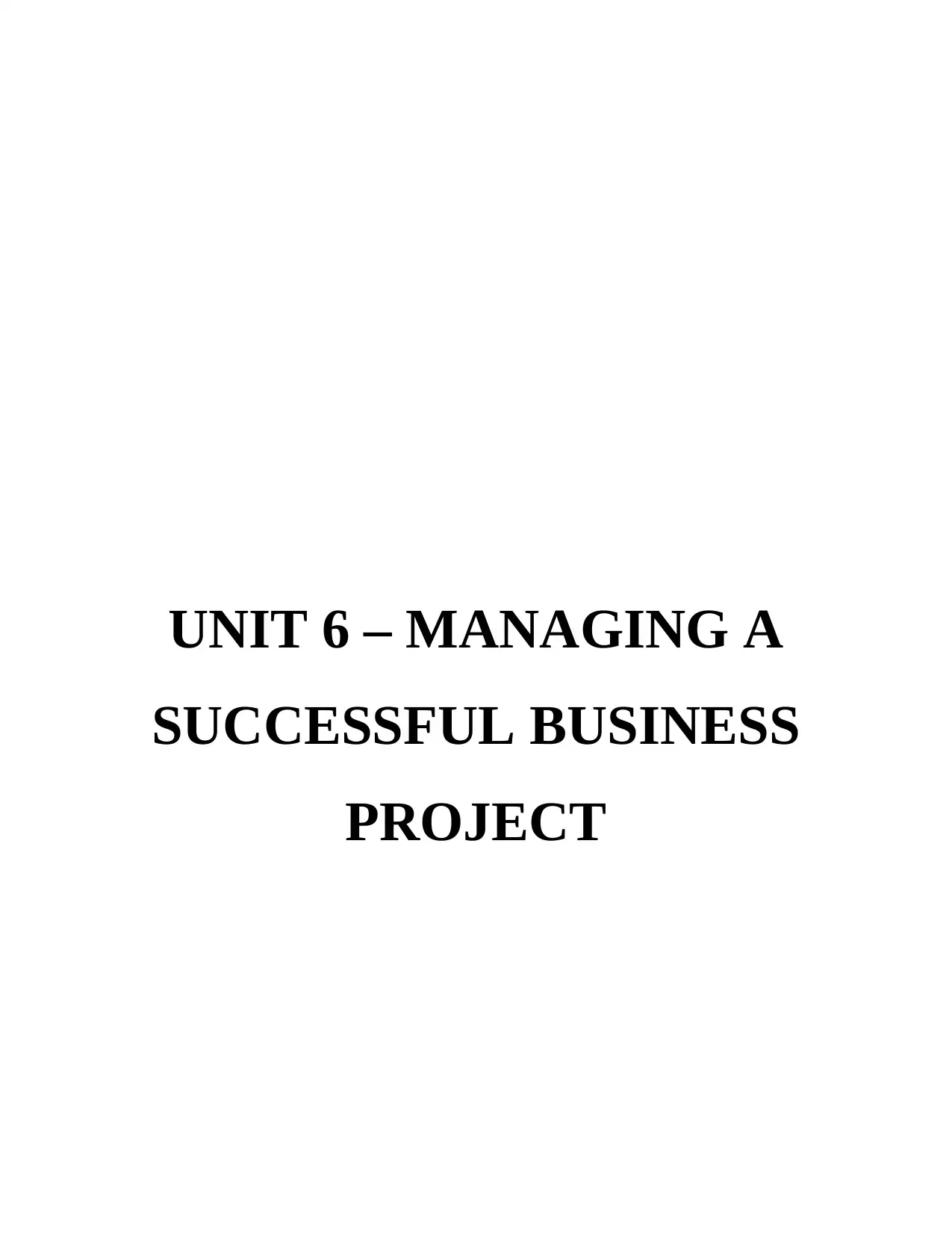
UNIT 6 – MANAGING A
SUCCESSFUL BUSINESS
PROJECT
SUCCESSFUL BUSINESS
PROJECT
Paraphrase This Document
Need a fresh take? Get an instant paraphrase of this document with our AI Paraphraser
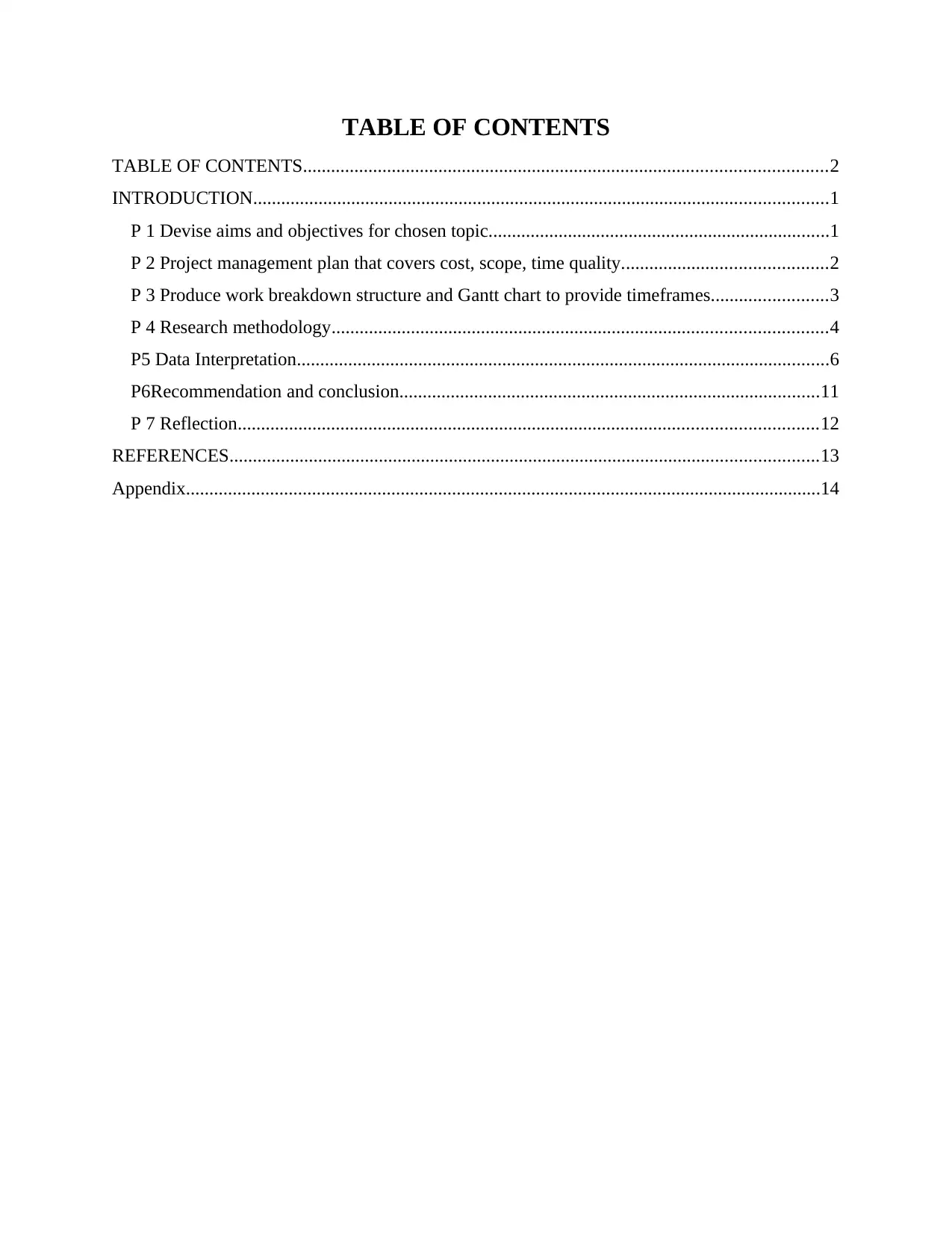
TABLE OF CONTENTS
TABLE OF CONTENTS................................................................................................................2
INTRODUCTION...........................................................................................................................1
P 1 Devise aims and objectives for chosen topic.........................................................................1
P 2 Project management plan that covers cost, scope, time quality............................................2
P 3 Produce work breakdown structure and Gantt chart to provide timeframes.........................3
P 4 Research methodology..........................................................................................................4
P5 Data Interpretation..................................................................................................................6
P6Recommendation and conclusion..........................................................................................11
P 7 Reflection............................................................................................................................12
REFERENCES..............................................................................................................................13
Appendix........................................................................................................................................14
TABLE OF CONTENTS................................................................................................................2
INTRODUCTION...........................................................................................................................1
P 1 Devise aims and objectives for chosen topic.........................................................................1
P 2 Project management plan that covers cost, scope, time quality............................................2
P 3 Produce work breakdown structure and Gantt chart to provide timeframes.........................3
P 4 Research methodology..........................................................................................................4
P5 Data Interpretation..................................................................................................................6
P6Recommendation and conclusion..........................................................................................11
P 7 Reflection............................................................................................................................12
REFERENCES..............................................................................................................................13
Appendix........................................................................................................................................14
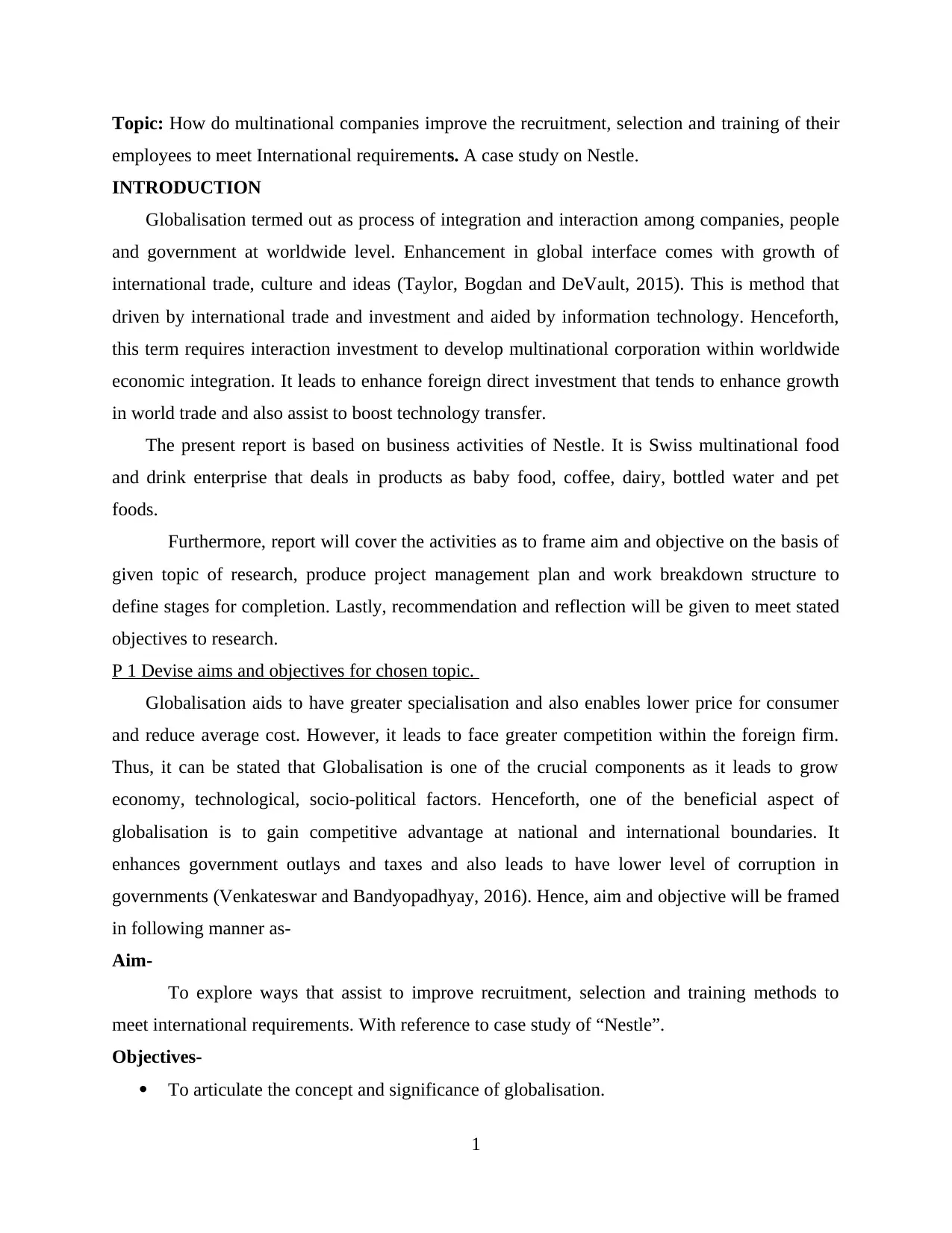
Topic: How do multinational companies improve the recruitment, selection and training of their
employees to meet International requirements. A case study on Nestle.
INTRODUCTION
Globalisation termed out as process of integration and interaction among companies, people
and government at worldwide level. Enhancement in global interface comes with growth of
international trade, culture and ideas (Taylor, Bogdan and DeVault, 2015). This is method that
driven by international trade and investment and aided by information technology. Henceforth,
this term requires interaction investment to develop multinational corporation within worldwide
economic integration. It leads to enhance foreign direct investment that tends to enhance growth
in world trade and also assist to boost technology transfer.
The present report is based on business activities of Nestle. It is Swiss multinational food
and drink enterprise that deals in products as baby food, coffee, dairy, bottled water and pet
foods.
Furthermore, report will cover the activities as to frame aim and objective on the basis of
given topic of research, produce project management plan and work breakdown structure to
define stages for completion. Lastly, recommendation and reflection will be given to meet stated
objectives to research.
P 1 Devise aims and objectives for chosen topic.
Globalisation aids to have greater specialisation and also enables lower price for consumer
and reduce average cost. However, it leads to face greater competition within the foreign firm.
Thus, it can be stated that Globalisation is one of the crucial components as it leads to grow
economy, technological, socio-political factors. Henceforth, one of the beneficial aspect of
globalisation is to gain competitive advantage at national and international boundaries. It
enhances government outlays and taxes and also leads to have lower level of corruption in
governments (Venkateswar and Bandyopadhyay, 2016). Hence, aim and objective will be framed
in following manner as-
Aim-
To explore ways that assist to improve recruitment, selection and training methods to
meet international requirements. With reference to case study of “Nestle”.
Objectives-
To articulate the concept and significance of globalisation.
1
employees to meet International requirements. A case study on Nestle.
INTRODUCTION
Globalisation termed out as process of integration and interaction among companies, people
and government at worldwide level. Enhancement in global interface comes with growth of
international trade, culture and ideas (Taylor, Bogdan and DeVault, 2015). This is method that
driven by international trade and investment and aided by information technology. Henceforth,
this term requires interaction investment to develop multinational corporation within worldwide
economic integration. It leads to enhance foreign direct investment that tends to enhance growth
in world trade and also assist to boost technology transfer.
The present report is based on business activities of Nestle. It is Swiss multinational food
and drink enterprise that deals in products as baby food, coffee, dairy, bottled water and pet
foods.
Furthermore, report will cover the activities as to frame aim and objective on the basis of
given topic of research, produce project management plan and work breakdown structure to
define stages for completion. Lastly, recommendation and reflection will be given to meet stated
objectives to research.
P 1 Devise aims and objectives for chosen topic.
Globalisation aids to have greater specialisation and also enables lower price for consumer
and reduce average cost. However, it leads to face greater competition within the foreign firm.
Thus, it can be stated that Globalisation is one of the crucial components as it leads to grow
economy, technological, socio-political factors. Henceforth, one of the beneficial aspect of
globalisation is to gain competitive advantage at national and international boundaries. It
enhances government outlays and taxes and also leads to have lower level of corruption in
governments (Venkateswar and Bandyopadhyay, 2016). Hence, aim and objective will be framed
in following manner as-
Aim-
To explore ways that assist to improve recruitment, selection and training methods to
meet international requirements. With reference to case study of “Nestle”.
Objectives-
To articulate the concept and significance of globalisation.
1
⊘ This is a preview!⊘
Do you want full access?
Subscribe today to unlock all pages.

Trusted by 1+ million students worldwide
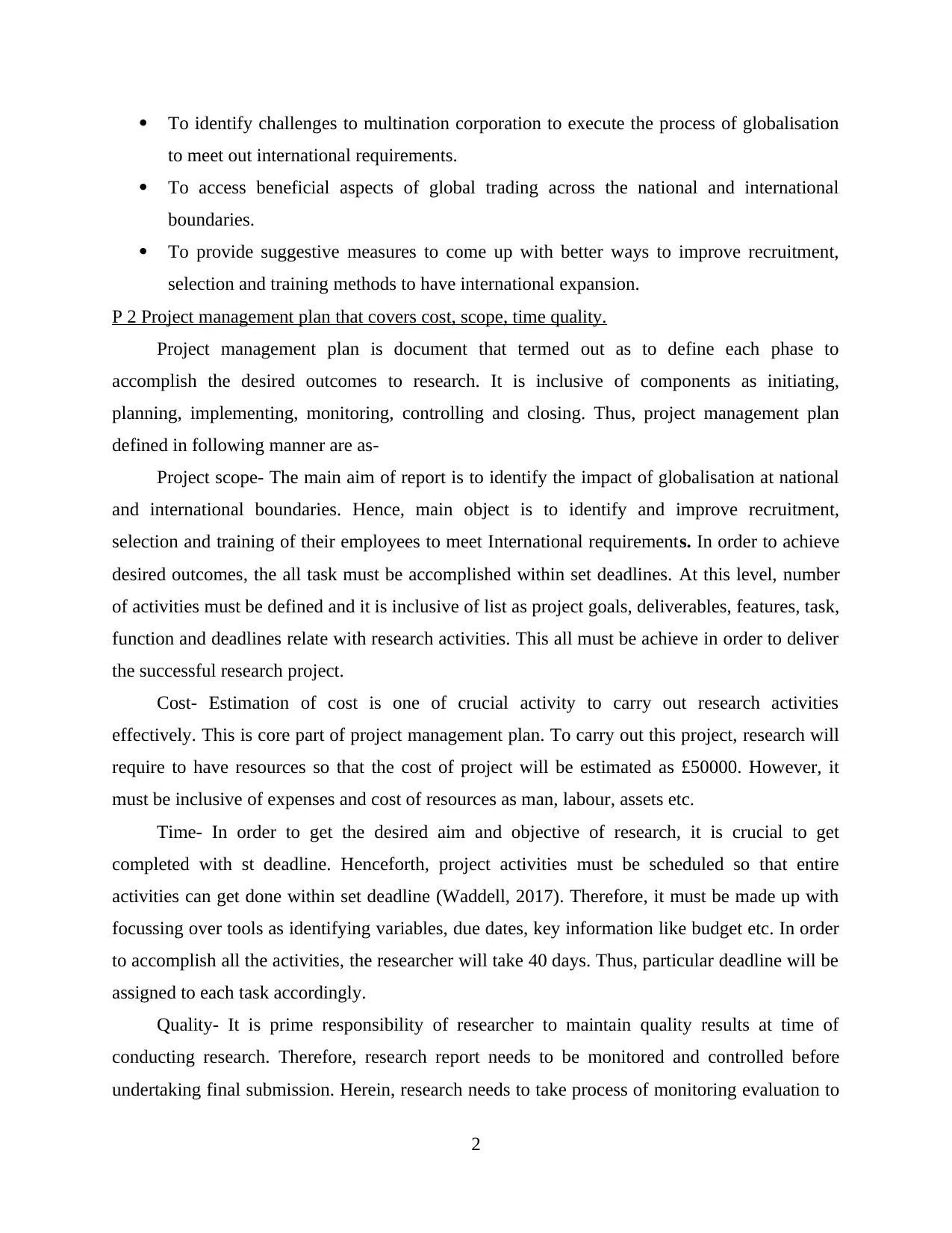
To identify challenges to multination corporation to execute the process of globalisation
to meet out international requirements.
To access beneficial aspects of global trading across the national and international
boundaries.
To provide suggestive measures to come up with better ways to improve recruitment,
selection and training methods to have international expansion.
P 2 Project management plan that covers cost, scope, time quality.
Project management plan is document that termed out as to define each phase to
accomplish the desired outcomes to research. It is inclusive of components as initiating,
planning, implementing, monitoring, controlling and closing. Thus, project management plan
defined in following manner are as-
Project scope- The main aim of report is to identify the impact of globalisation at national
and international boundaries. Hence, main object is to identify and improve recruitment,
selection and training of their employees to meet International requirements. In order to achieve
desired outcomes, the all task must be accomplished within set deadlines. At this level, number
of activities must be defined and it is inclusive of list as project goals, deliverables, features, task,
function and deadlines relate with research activities. This all must be achieve in order to deliver
the successful research project.
Cost- Estimation of cost is one of crucial activity to carry out research activities
effectively. This is core part of project management plan. To carry out this project, research will
require to have resources so that the cost of project will be estimated as £50000. However, it
must be inclusive of expenses and cost of resources as man, labour, assets etc.
Time- In order to get the desired aim and objective of research, it is crucial to get
completed with st deadline. Henceforth, project activities must be scheduled so that entire
activities can get done within set deadline (Waddell, 2017). Therefore, it must be made up with
focussing over tools as identifying variables, due dates, key information like budget etc. In order
to accomplish all the activities, the researcher will take 40 days. Thus, particular deadline will be
assigned to each task accordingly.
Quality- It is prime responsibility of researcher to maintain quality results at time of
conducting research. Therefore, research report needs to be monitored and controlled before
undertaking final submission. Herein, research needs to take process of monitoring evaluation to
2
to meet out international requirements.
To access beneficial aspects of global trading across the national and international
boundaries.
To provide suggestive measures to come up with better ways to improve recruitment,
selection and training methods to have international expansion.
P 2 Project management plan that covers cost, scope, time quality.
Project management plan is document that termed out as to define each phase to
accomplish the desired outcomes to research. It is inclusive of components as initiating,
planning, implementing, monitoring, controlling and closing. Thus, project management plan
defined in following manner are as-
Project scope- The main aim of report is to identify the impact of globalisation at national
and international boundaries. Hence, main object is to identify and improve recruitment,
selection and training of their employees to meet International requirements. In order to achieve
desired outcomes, the all task must be accomplished within set deadlines. At this level, number
of activities must be defined and it is inclusive of list as project goals, deliverables, features, task,
function and deadlines relate with research activities. This all must be achieve in order to deliver
the successful research project.
Cost- Estimation of cost is one of crucial activity to carry out research activities
effectively. This is core part of project management plan. To carry out this project, research will
require to have resources so that the cost of project will be estimated as £50000. However, it
must be inclusive of expenses and cost of resources as man, labour, assets etc.
Time- In order to get the desired aim and objective of research, it is crucial to get
completed with st deadline. Henceforth, project activities must be scheduled so that entire
activities can get done within set deadline (Waddell, 2017). Therefore, it must be made up with
focussing over tools as identifying variables, due dates, key information like budget etc. In order
to accomplish all the activities, the researcher will take 40 days. Thus, particular deadline will be
assigned to each task accordingly.
Quality- It is prime responsibility of researcher to maintain quality results at time of
conducting research. Therefore, research report needs to be monitored and controlled before
undertaking final submission. Herein, research needs to take process of monitoring evaluation to
2
Paraphrase This Document
Need a fresh take? Get an instant paraphrase of this document with our AI Paraphraser
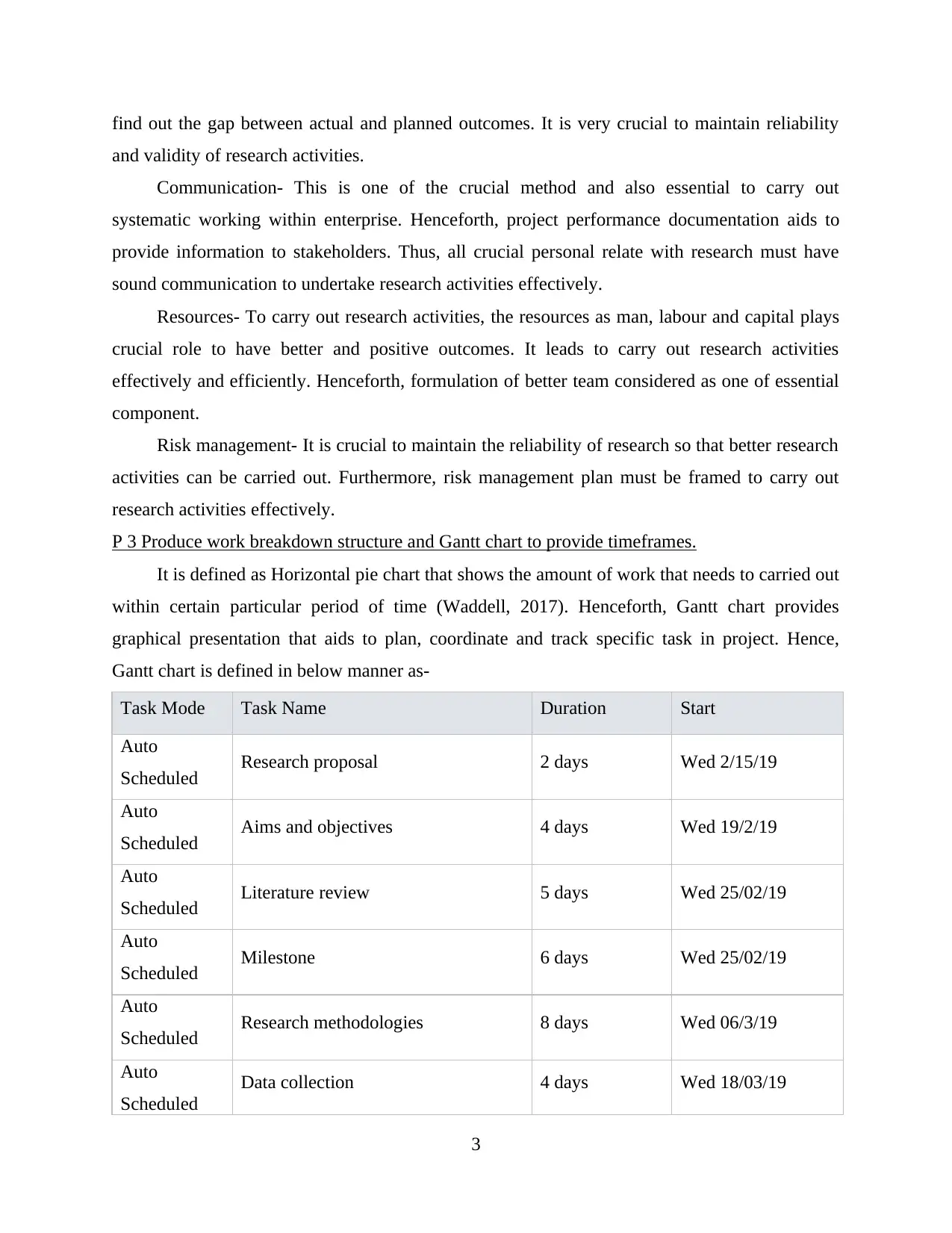
find out the gap between actual and planned outcomes. It is very crucial to maintain reliability
and validity of research activities.
Communication- This is one of the crucial method and also essential to carry out
systematic working within enterprise. Henceforth, project performance documentation aids to
provide information to stakeholders. Thus, all crucial personal relate with research must have
sound communication to undertake research activities effectively.
Resources- To carry out research activities, the resources as man, labour and capital plays
crucial role to have better and positive outcomes. It leads to carry out research activities
effectively and efficiently. Henceforth, formulation of better team considered as one of essential
component.
Risk management- It is crucial to maintain the reliability of research so that better research
activities can be carried out. Furthermore, risk management plan must be framed to carry out
research activities effectively.
P 3 Produce work breakdown structure and Gantt chart to provide timeframes.
It is defined as Horizontal pie chart that shows the amount of work that needs to carried out
within certain particular period of time (Waddell, 2017). Henceforth, Gantt chart provides
graphical presentation that aids to plan, coordinate and track specific task in project. Hence,
Gantt chart is defined in below manner as-
Task Mode Task Name Duration Start
Auto
Scheduled Research proposal 2 days Wed 2/15/19
Auto
Scheduled Aims and objectives 4 days Wed 19/2/19
Auto
Scheduled Literature review 5 days Wed 25/02/19
Auto
Scheduled Milestone 6 days Wed 25/02/19
Auto
Scheduled Research methodologies 8 days Wed 06/3/19
Auto
Scheduled
Data collection 4 days Wed 18/03/19
3
and validity of research activities.
Communication- This is one of the crucial method and also essential to carry out
systematic working within enterprise. Henceforth, project performance documentation aids to
provide information to stakeholders. Thus, all crucial personal relate with research must have
sound communication to undertake research activities effectively.
Resources- To carry out research activities, the resources as man, labour and capital plays
crucial role to have better and positive outcomes. It leads to carry out research activities
effectively and efficiently. Henceforth, formulation of better team considered as one of essential
component.
Risk management- It is crucial to maintain the reliability of research so that better research
activities can be carried out. Furthermore, risk management plan must be framed to carry out
research activities effectively.
P 3 Produce work breakdown structure and Gantt chart to provide timeframes.
It is defined as Horizontal pie chart that shows the amount of work that needs to carried out
within certain particular period of time (Waddell, 2017). Henceforth, Gantt chart provides
graphical presentation that aids to plan, coordinate and track specific task in project. Hence,
Gantt chart is defined in below manner as-
Task Mode Task Name Duration Start
Auto
Scheduled Research proposal 2 days Wed 2/15/19
Auto
Scheduled Aims and objectives 4 days Wed 19/2/19
Auto
Scheduled Literature review 5 days Wed 25/02/19
Auto
Scheduled Milestone 6 days Wed 25/02/19
Auto
Scheduled Research methodologies 8 days Wed 06/3/19
Auto
Scheduled
Data collection 4 days Wed 18/03/19
3
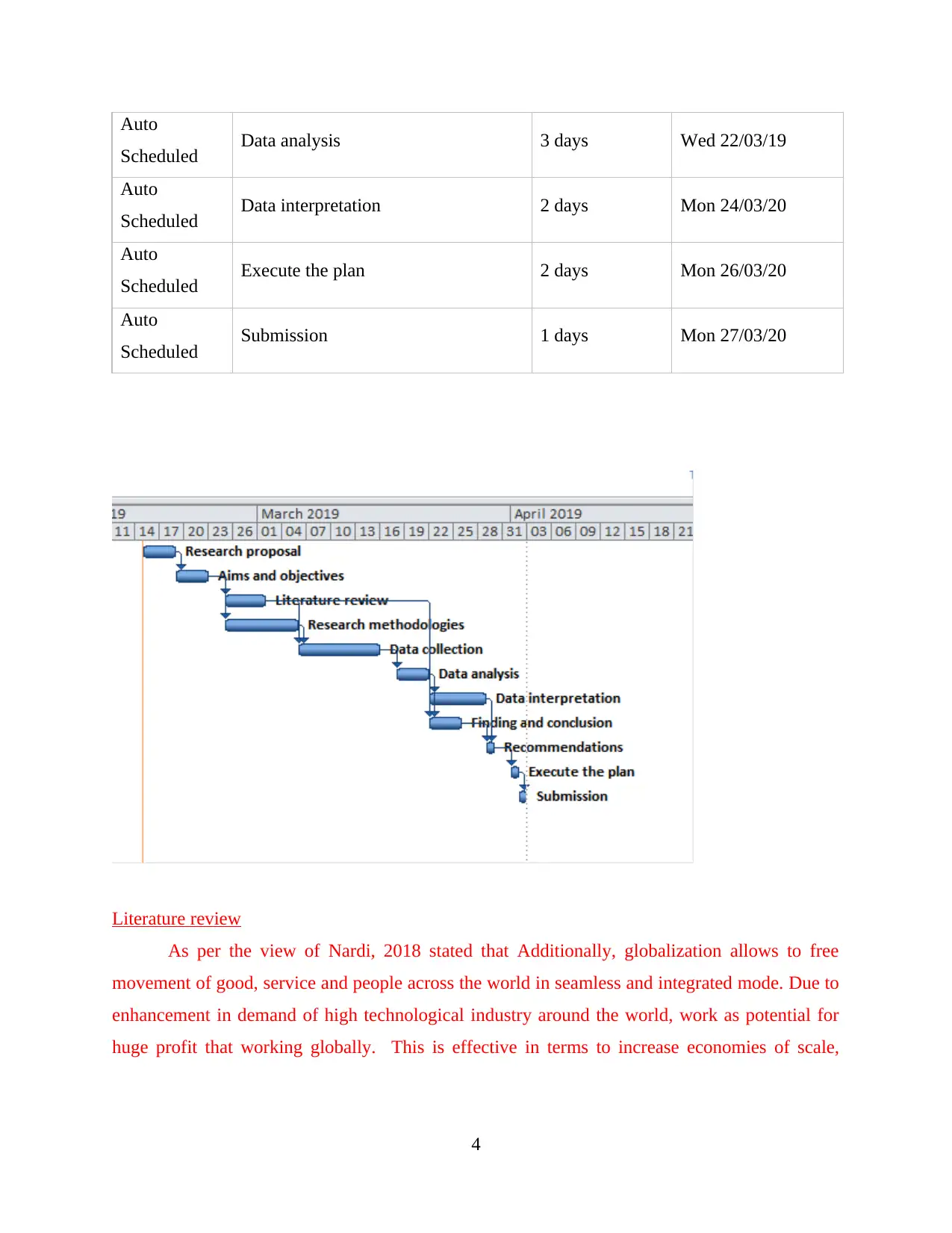
Auto
Scheduled Data analysis 3 days Wed 22/03/19
Auto
Scheduled Data interpretation 2 days Mon 24/03/20
Auto
Scheduled Execute the plan 2 days Mon 26/03/20
Auto
Scheduled Submission 1 days Mon 27/03/20
Literature review
As per the view of Nardi, 2018 stated that Additionally, globalization allows to free
movement of good, service and people across the world in seamless and integrated mode. Due to
enhancement in demand of high technological industry around the world, work as potential for
huge profit that working globally. This is effective in terms to increase economies of scale,
4
Scheduled Data analysis 3 days Wed 22/03/19
Auto
Scheduled Data interpretation 2 days Mon 24/03/20
Auto
Scheduled Execute the plan 2 days Mon 26/03/20
Auto
Scheduled Submission 1 days Mon 27/03/20
Literature review
As per the view of Nardi, 2018 stated that Additionally, globalization allows to free
movement of good, service and people across the world in seamless and integrated mode. Due to
enhancement in demand of high technological industry around the world, work as potential for
huge profit that working globally. This is effective in terms to increase economies of scale,
4
⊘ This is a preview!⊘
Do you want full access?
Subscribe today to unlock all pages.

Trusted by 1+ million students worldwide
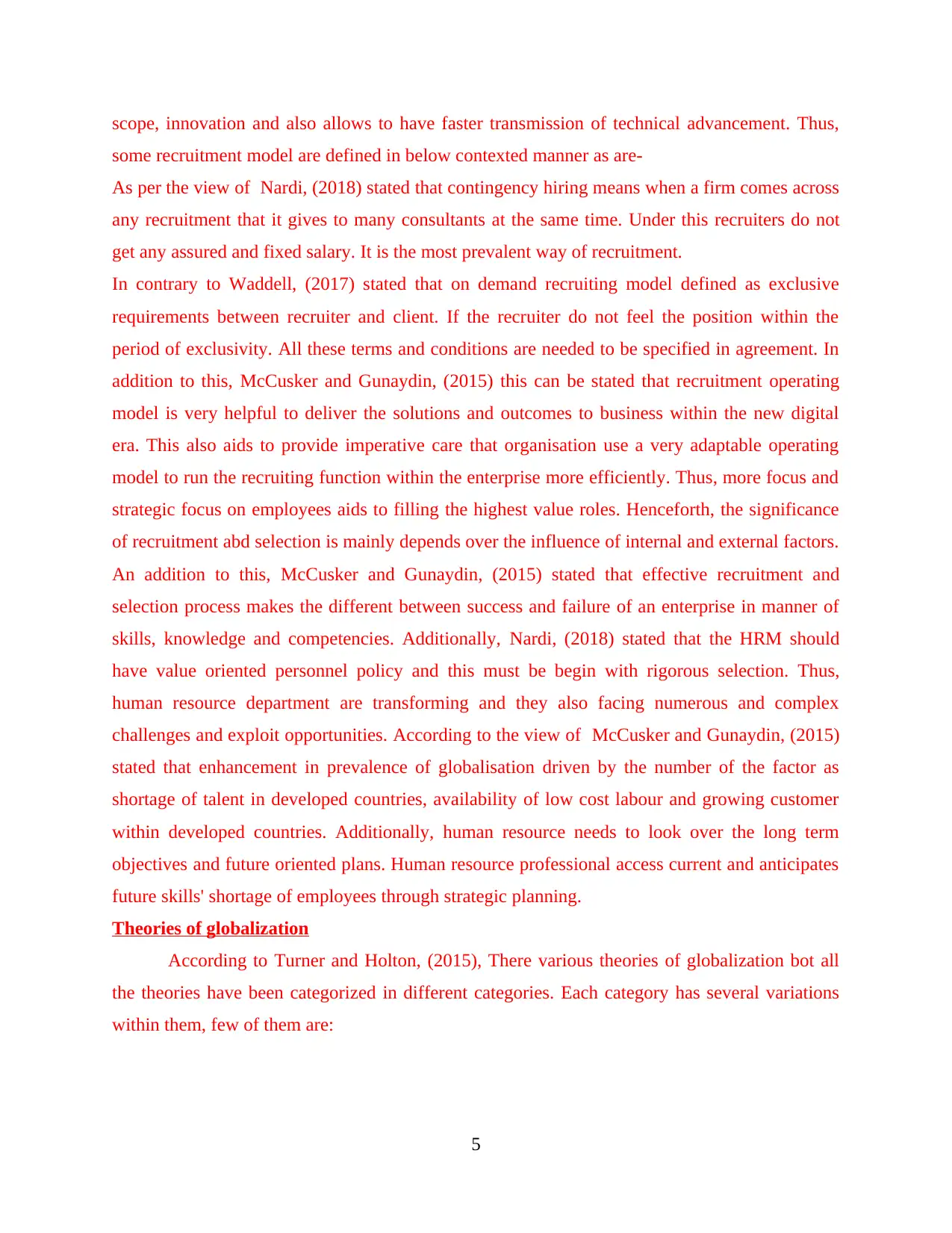
scope, innovation and also allows to have faster transmission of technical advancement. Thus,
some recruitment model are defined in below contexted manner as are-
As per the view of Nardi, (2018) stated that contingency hiring means when a firm comes across
any recruitment that it gives to many consultants at the same time. Under this recruiters do not
get any assured and fixed salary. It is the most prevalent way of recruitment.
In contrary to Waddell, (2017) stated that on demand recruiting model defined as exclusive
requirements between recruiter and client. If the recruiter do not feel the position within the
period of exclusivity. All these terms and conditions are needed to be specified in agreement. In
addition to this, McCusker and Gunaydin, (2015) this can be stated that recruitment operating
model is very helpful to deliver the solutions and outcomes to business within the new digital
era. This also aids to provide imperative care that organisation use a very adaptable operating
model to run the recruiting function within the enterprise more efficiently. Thus, more focus and
strategic focus on employees aids to filling the highest value roles. Henceforth, the significance
of recruitment abd selection is mainly depends over the influence of internal and external factors.
An addition to this, McCusker and Gunaydin, (2015) stated that effective recruitment and
selection process makes the different between success and failure of an enterprise in manner of
skills, knowledge and competencies. Additionally, Nardi, (2018) stated that the HRM should
have value oriented personnel policy and this must be begin with rigorous selection. Thus,
human resource department are transforming and they also facing numerous and complex
challenges and exploit opportunities. According to the view of McCusker and Gunaydin, (2015)
stated that enhancement in prevalence of globalisation driven by the number of the factor as
shortage of talent in developed countries, availability of low cost labour and growing customer
within developed countries. Additionally, human resource needs to look over the long term
objectives and future oriented plans. Human resource professional access current and anticipates
future skills' shortage of employees through strategic planning.
Theories of globalization
According to Turner and Holton, (2015), There various theories of globalization bot all
the theories have been categorized in different categories. Each category has several variations
within them, few of them are:
5
some recruitment model are defined in below contexted manner as are-
As per the view of Nardi, (2018) stated that contingency hiring means when a firm comes across
any recruitment that it gives to many consultants at the same time. Under this recruiters do not
get any assured and fixed salary. It is the most prevalent way of recruitment.
In contrary to Waddell, (2017) stated that on demand recruiting model defined as exclusive
requirements between recruiter and client. If the recruiter do not feel the position within the
period of exclusivity. All these terms and conditions are needed to be specified in agreement. In
addition to this, McCusker and Gunaydin, (2015) this can be stated that recruitment operating
model is very helpful to deliver the solutions and outcomes to business within the new digital
era. This also aids to provide imperative care that organisation use a very adaptable operating
model to run the recruiting function within the enterprise more efficiently. Thus, more focus and
strategic focus on employees aids to filling the highest value roles. Henceforth, the significance
of recruitment abd selection is mainly depends over the influence of internal and external factors.
An addition to this, McCusker and Gunaydin, (2015) stated that effective recruitment and
selection process makes the different between success and failure of an enterprise in manner of
skills, knowledge and competencies. Additionally, Nardi, (2018) stated that the HRM should
have value oriented personnel policy and this must be begin with rigorous selection. Thus,
human resource department are transforming and they also facing numerous and complex
challenges and exploit opportunities. According to the view of McCusker and Gunaydin, (2015)
stated that enhancement in prevalence of globalisation driven by the number of the factor as
shortage of talent in developed countries, availability of low cost labour and growing customer
within developed countries. Additionally, human resource needs to look over the long term
objectives and future oriented plans. Human resource professional access current and anticipates
future skills' shortage of employees through strategic planning.
Theories of globalization
According to Turner and Holton, (2015), There various theories of globalization bot all
the theories have been categorized in different categories. Each category has several variations
within them, few of them are:
5
Paraphrase This Document
Need a fresh take? Get an instant paraphrase of this document with our AI Paraphraser
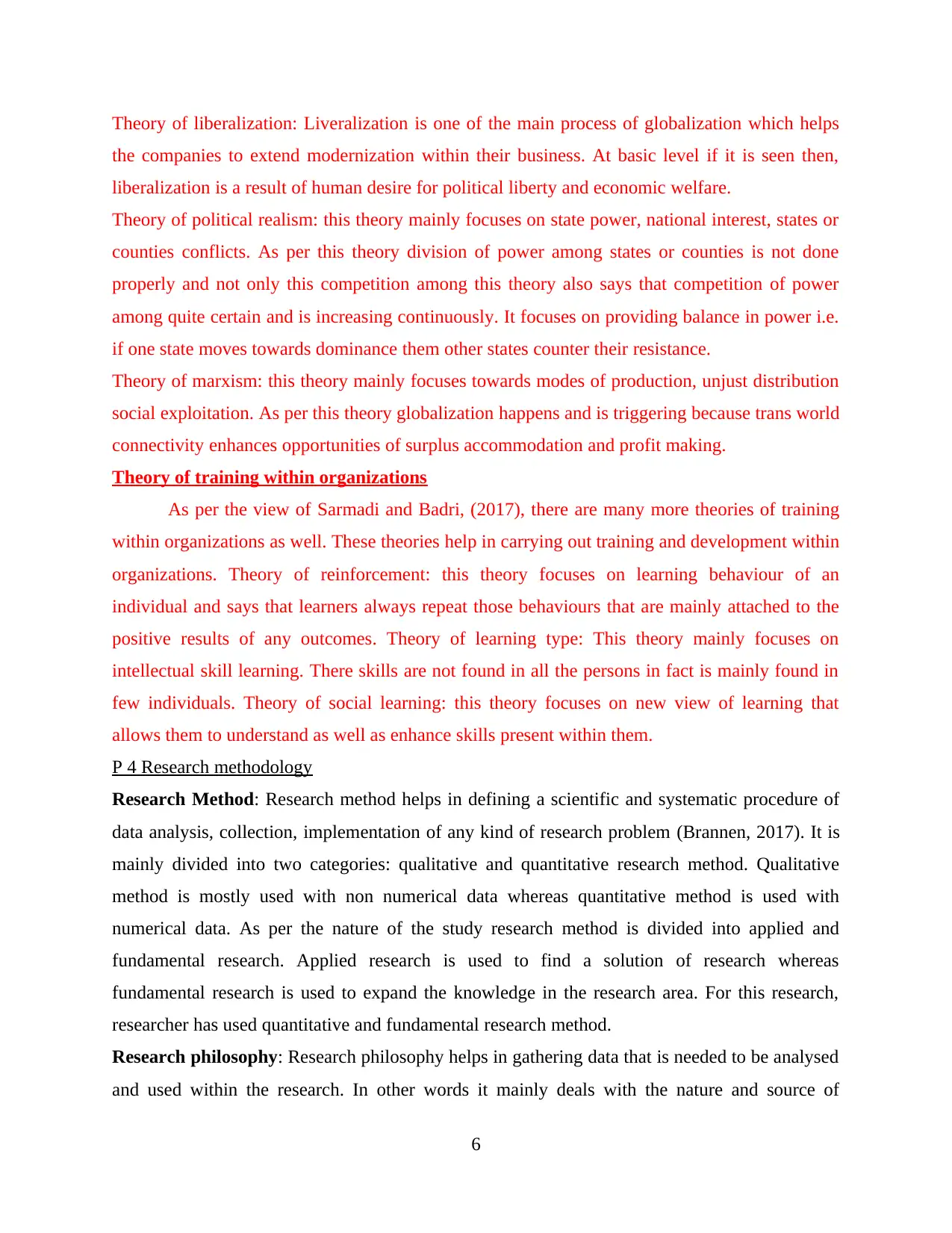
Theory of liberalization: Liveralization is one of the main process of globalization which helps
the companies to extend modernization within their business. At basic level if it is seen then,
liberalization is a result of human desire for political liberty and economic welfare.
Theory of political realism: this theory mainly focuses on state power, national interest, states or
counties conflicts. As per this theory division of power among states or counties is not done
properly and not only this competition among this theory also says that competition of power
among quite certain and is increasing continuously. It focuses on providing balance in power i.e.
if one state moves towards dominance them other states counter their resistance.
Theory of marxism: this theory mainly focuses towards modes of production, unjust distribution
social exploitation. As per this theory globalization happens and is triggering because trans world
connectivity enhances opportunities of surplus accommodation and profit making.
Theory of training within organizations
As per the view of Sarmadi and Badri, (2017), there are many more theories of training
within organizations as well. These theories help in carrying out training and development within
organizations. Theory of reinforcement: this theory focuses on learning behaviour of an
individual and says that learners always repeat those behaviours that are mainly attached to the
positive results of any outcomes. Theory of learning type: This theory mainly focuses on
intellectual skill learning. There skills are not found in all the persons in fact is mainly found in
few individuals. Theory of social learning: this theory focuses on new view of learning that
allows them to understand as well as enhance skills present within them.
P 4 Research methodology
Research Method: Research method helps in defining a scientific and systematic procedure of
data analysis, collection, implementation of any kind of research problem (Brannen, 2017). It is
mainly divided into two categories: qualitative and quantitative research method. Qualitative
method is mostly used with non numerical data whereas quantitative method is used with
numerical data. As per the nature of the study research method is divided into applied and
fundamental research. Applied research is used to find a solution of research whereas
fundamental research is used to expand the knowledge in the research area. For this research,
researcher has used quantitative and fundamental research method.
Research philosophy: Research philosophy helps in gathering data that is needed to be analysed
and used within the research. In other words it mainly deals with the nature and source of
6
the companies to extend modernization within their business. At basic level if it is seen then,
liberalization is a result of human desire for political liberty and economic welfare.
Theory of political realism: this theory mainly focuses on state power, national interest, states or
counties conflicts. As per this theory division of power among states or counties is not done
properly and not only this competition among this theory also says that competition of power
among quite certain and is increasing continuously. It focuses on providing balance in power i.e.
if one state moves towards dominance them other states counter their resistance.
Theory of marxism: this theory mainly focuses towards modes of production, unjust distribution
social exploitation. As per this theory globalization happens and is triggering because trans world
connectivity enhances opportunities of surplus accommodation and profit making.
Theory of training within organizations
As per the view of Sarmadi and Badri, (2017), there are many more theories of training
within organizations as well. These theories help in carrying out training and development within
organizations. Theory of reinforcement: this theory focuses on learning behaviour of an
individual and says that learners always repeat those behaviours that are mainly attached to the
positive results of any outcomes. Theory of learning type: This theory mainly focuses on
intellectual skill learning. There skills are not found in all the persons in fact is mainly found in
few individuals. Theory of social learning: this theory focuses on new view of learning that
allows them to understand as well as enhance skills present within them.
P 4 Research methodology
Research Method: Research method helps in defining a scientific and systematic procedure of
data analysis, collection, implementation of any kind of research problem (Brannen, 2017). It is
mainly divided into two categories: qualitative and quantitative research method. Qualitative
method is mostly used with non numerical data whereas quantitative method is used with
numerical data. As per the nature of the study research method is divided into applied and
fundamental research. Applied research is used to find a solution of research whereas
fundamental research is used to expand the knowledge in the research area. For this research,
researcher has used quantitative and fundamental research method.
Research philosophy: Research philosophy helps in gathering data that is needed to be analysed
and used within the research. In other words it mainly deals with the nature and source of
6
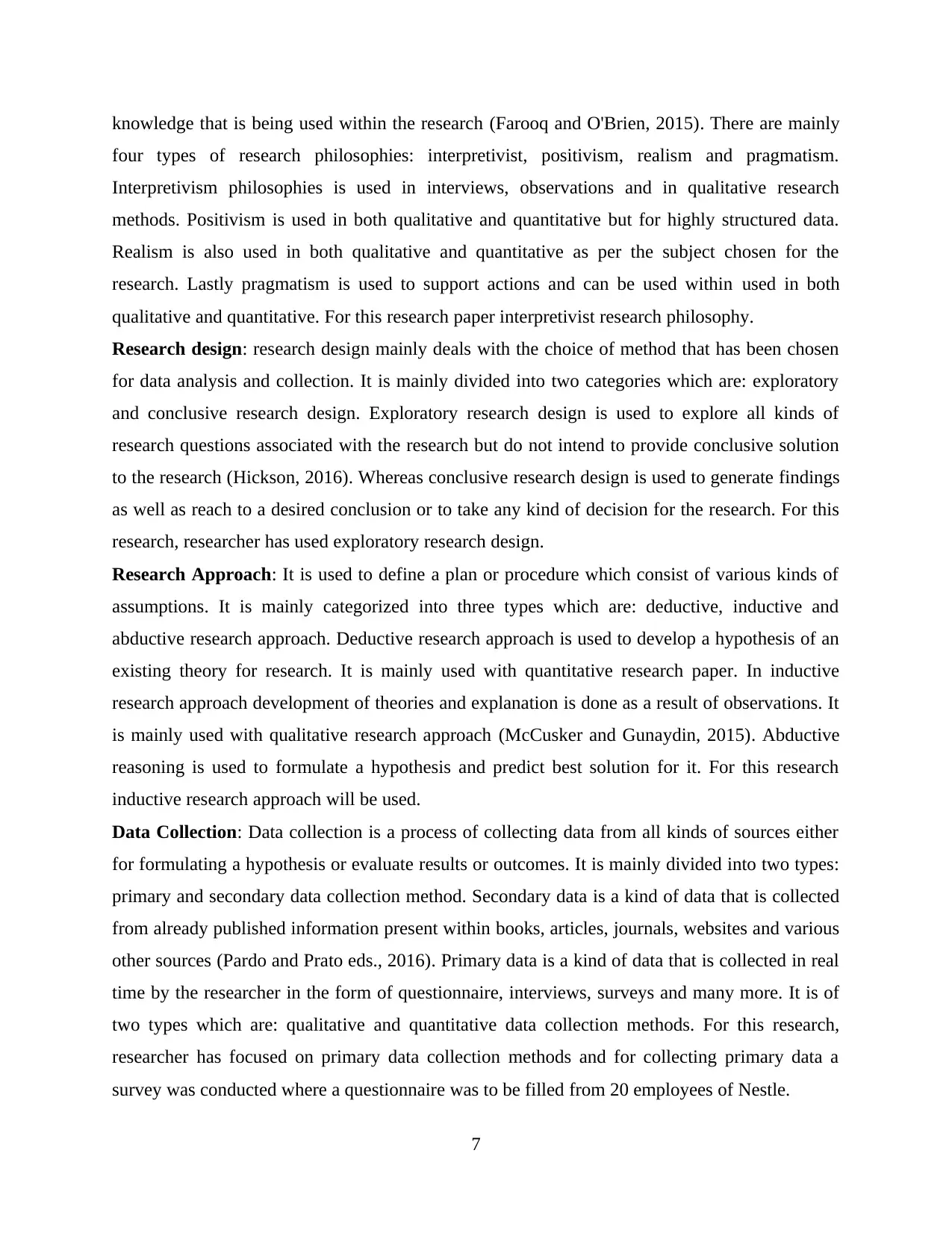
knowledge that is being used within the research (Farooq and O'Brien, 2015). There are mainly
four types of research philosophies: interpretivist, positivism, realism and pragmatism.
Interpretivism philosophies is used in interviews, observations and in qualitative research
methods. Positivism is used in both qualitative and quantitative but for highly structured data.
Realism is also used in both qualitative and quantitative as per the subject chosen for the
research. Lastly pragmatism is used to support actions and can be used within used in both
qualitative and quantitative. For this research paper interpretivist research philosophy.
Research design: research design mainly deals with the choice of method that has been chosen
for data analysis and collection. It is mainly divided into two categories which are: exploratory
and conclusive research design. Exploratory research design is used to explore all kinds of
research questions associated with the research but do not intend to provide conclusive solution
to the research (Hickson, 2016). Whereas conclusive research design is used to generate findings
as well as reach to a desired conclusion or to take any kind of decision for the research. For this
research, researcher has used exploratory research design.
Research Approach: It is used to define a plan or procedure which consist of various kinds of
assumptions. It is mainly categorized into three types which are: deductive, inductive and
abductive research approach. Deductive research approach is used to develop a hypothesis of an
existing theory for research. It is mainly used with quantitative research paper. In inductive
research approach development of theories and explanation is done as a result of observations. It
is mainly used with qualitative research approach (McCusker and Gunaydin, 2015). Abductive
reasoning is used to formulate a hypothesis and predict best solution for it. For this research
inductive research approach will be used.
Data Collection: Data collection is a process of collecting data from all kinds of sources either
for formulating a hypothesis or evaluate results or outcomes. It is mainly divided into two types:
primary and secondary data collection method. Secondary data is a kind of data that is collected
from already published information present within books, articles, journals, websites and various
other sources (Pardo and Prato eds., 2016). Primary data is a kind of data that is collected in real
time by the researcher in the form of questionnaire, interviews, surveys and many more. It is of
two types which are: qualitative and quantitative data collection methods. For this research,
researcher has focused on primary data collection methods and for collecting primary data a
survey was conducted where a questionnaire was to be filled from 20 employees of Nestle.
7
four types of research philosophies: interpretivist, positivism, realism and pragmatism.
Interpretivism philosophies is used in interviews, observations and in qualitative research
methods. Positivism is used in both qualitative and quantitative but for highly structured data.
Realism is also used in both qualitative and quantitative as per the subject chosen for the
research. Lastly pragmatism is used to support actions and can be used within used in both
qualitative and quantitative. For this research paper interpretivist research philosophy.
Research design: research design mainly deals with the choice of method that has been chosen
for data analysis and collection. It is mainly divided into two categories which are: exploratory
and conclusive research design. Exploratory research design is used to explore all kinds of
research questions associated with the research but do not intend to provide conclusive solution
to the research (Hickson, 2016). Whereas conclusive research design is used to generate findings
as well as reach to a desired conclusion or to take any kind of decision for the research. For this
research, researcher has used exploratory research design.
Research Approach: It is used to define a plan or procedure which consist of various kinds of
assumptions. It is mainly categorized into three types which are: deductive, inductive and
abductive research approach. Deductive research approach is used to develop a hypothesis of an
existing theory for research. It is mainly used with quantitative research paper. In inductive
research approach development of theories and explanation is done as a result of observations. It
is mainly used with qualitative research approach (McCusker and Gunaydin, 2015). Abductive
reasoning is used to formulate a hypothesis and predict best solution for it. For this research
inductive research approach will be used.
Data Collection: Data collection is a process of collecting data from all kinds of sources either
for formulating a hypothesis or evaluate results or outcomes. It is mainly divided into two types:
primary and secondary data collection method. Secondary data is a kind of data that is collected
from already published information present within books, articles, journals, websites and various
other sources (Pardo and Prato eds., 2016). Primary data is a kind of data that is collected in real
time by the researcher in the form of questionnaire, interviews, surveys and many more. It is of
two types which are: qualitative and quantitative data collection methods. For this research,
researcher has focused on primary data collection methods and for collecting primary data a
survey was conducted where a questionnaire was to be filled from 20 employees of Nestle.
7
⊘ This is a preview!⊘
Do you want full access?
Subscribe today to unlock all pages.

Trusted by 1+ million students worldwide
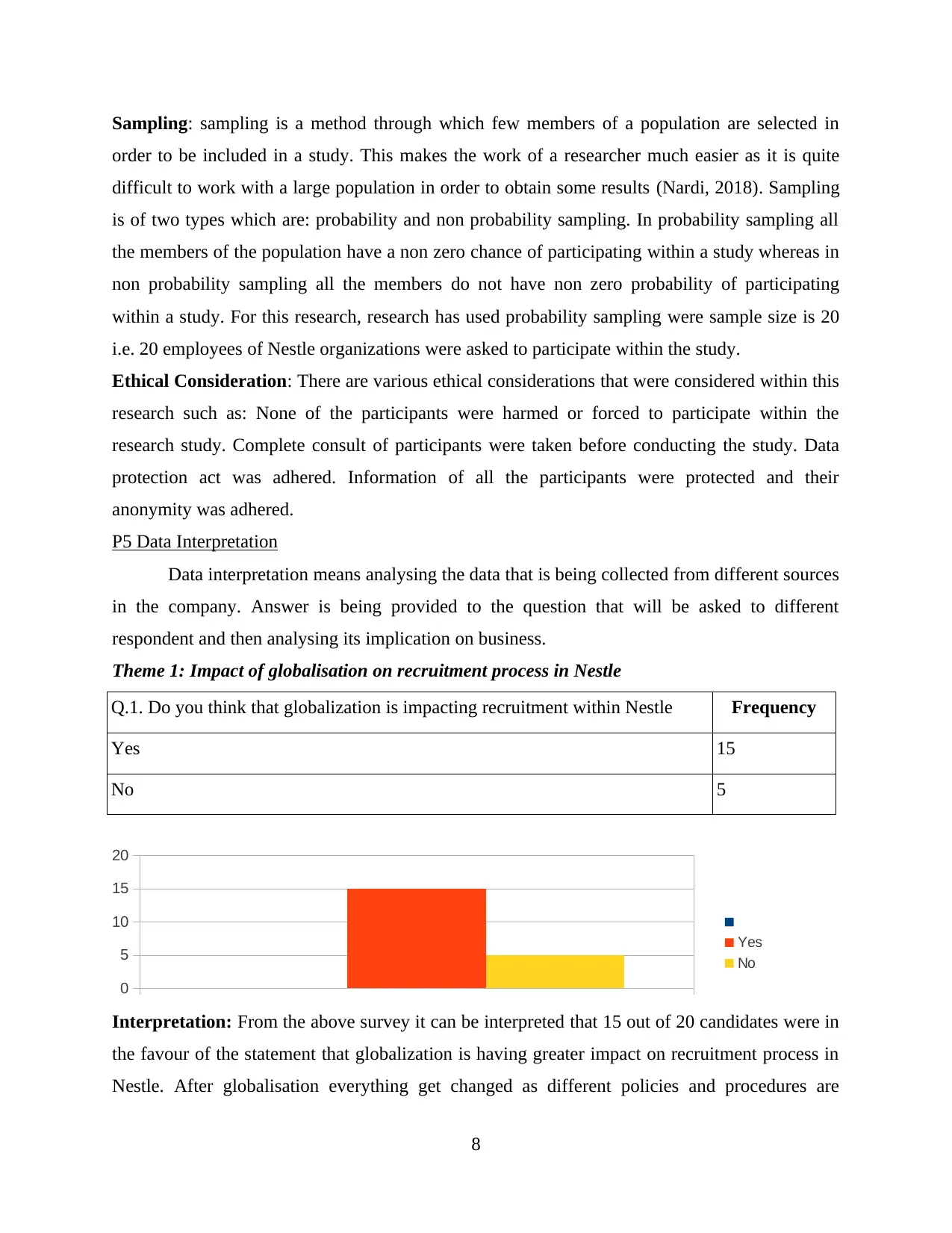
Sampling: sampling is a method through which few members of a population are selected in
order to be included in a study. This makes the work of a researcher much easier as it is quite
difficult to work with a large population in order to obtain some results (Nardi, 2018). Sampling
is of two types which are: probability and non probability sampling. In probability sampling all
the members of the population have a non zero chance of participating within a study whereas in
non probability sampling all the members do not have non zero probability of participating
within a study. For this research, research has used probability sampling were sample size is 20
i.e. 20 employees of Nestle organizations were asked to participate within the study.
Ethical Consideration: There are various ethical considerations that were considered within this
research such as: None of the participants were harmed or forced to participate within the
research study. Complete consult of participants were taken before conducting the study. Data
protection act was adhered. Information of all the participants were protected and their
anonymity was adhered.
P5 Data Interpretation
Data interpretation means analysing the data that is being collected from different sources
in the company. Answer is being provided to the question that will be asked to different
respondent and then analysing its implication on business.
Theme 1: Impact of globalisation on recruitment process in Nestle
Q.1. Do you think that globalization is impacting recruitment within Nestle Frequency
Yes 15
No 5
0
5
10
15
20
Interpretation: From the above survey it can be interpreted that 15 out of 20 candidates were in
the favour of the statement that globalization is having greater impact on recruitment process in
Nestle. After globalisation everything get changed as different policies and procedures are
8
Yes
No
order to be included in a study. This makes the work of a researcher much easier as it is quite
difficult to work with a large population in order to obtain some results (Nardi, 2018). Sampling
is of two types which are: probability and non probability sampling. In probability sampling all
the members of the population have a non zero chance of participating within a study whereas in
non probability sampling all the members do not have non zero probability of participating
within a study. For this research, research has used probability sampling were sample size is 20
i.e. 20 employees of Nestle organizations were asked to participate within the study.
Ethical Consideration: There are various ethical considerations that were considered within this
research such as: None of the participants were harmed or forced to participate within the
research study. Complete consult of participants were taken before conducting the study. Data
protection act was adhered. Information of all the participants were protected and their
anonymity was adhered.
P5 Data Interpretation
Data interpretation means analysing the data that is being collected from different sources
in the company. Answer is being provided to the question that will be asked to different
respondent and then analysing its implication on business.
Theme 1: Impact of globalisation on recruitment process in Nestle
Q.1. Do you think that globalization is impacting recruitment within Nestle Frequency
Yes 15
No 5
0
5
10
15
20
Interpretation: From the above survey it can be interpreted that 15 out of 20 candidates were in
the favour of the statement that globalization is having greater impact on recruitment process in
Nestle. After globalisation everything get changed as different policies and procedures are
8
Yes
No
Paraphrase This Document
Need a fresh take? Get an instant paraphrase of this document with our AI Paraphraser
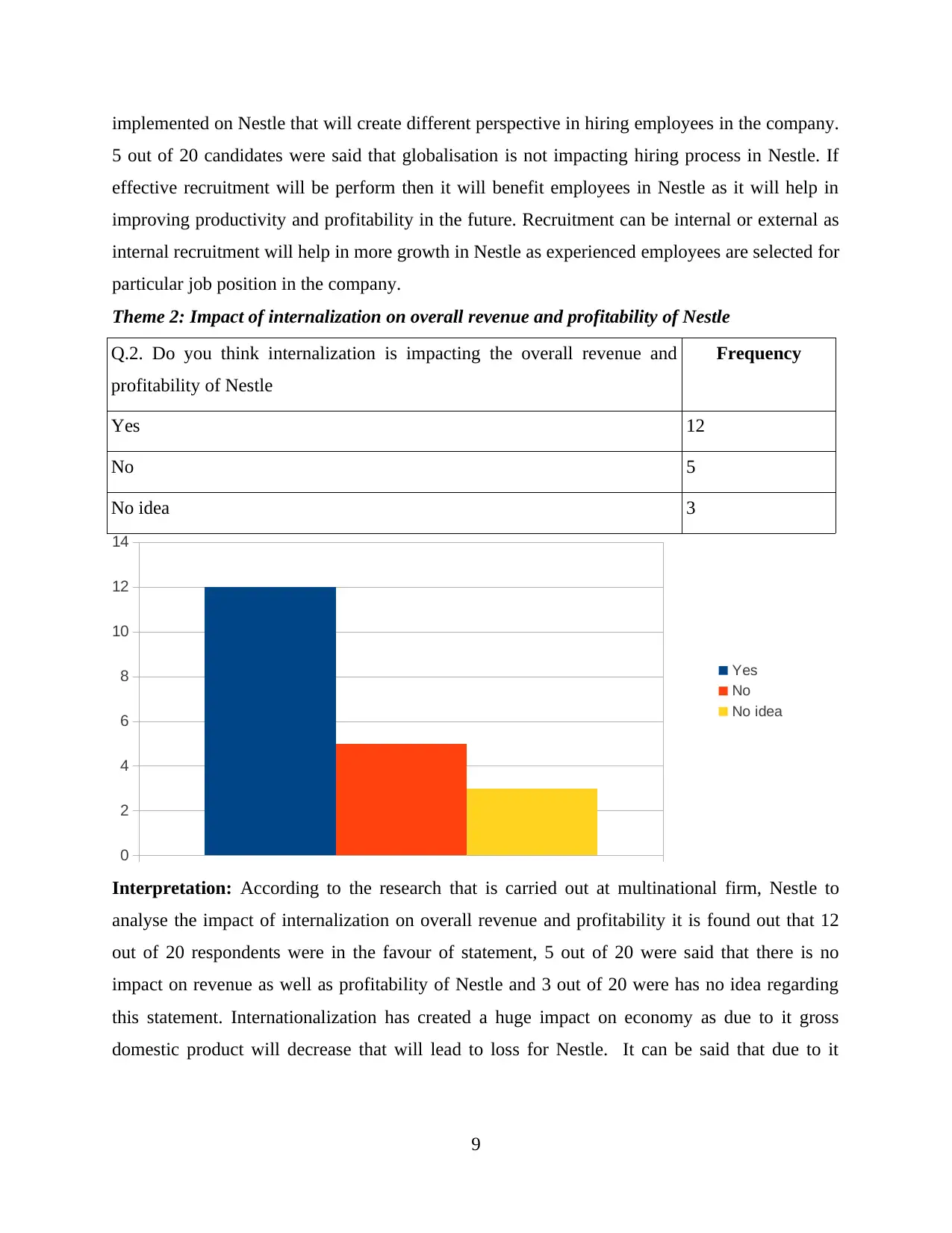
implemented on Nestle that will create different perspective in hiring employees in the company.
5 out of 20 candidates were said that globalisation is not impacting hiring process in Nestle. If
effective recruitment will be perform then it will benefit employees in Nestle as it will help in
improving productivity and profitability in the future. Recruitment can be internal or external as
internal recruitment will help in more growth in Nestle as experienced employees are selected for
particular job position in the company.
Theme 2: Impact of internalization on overall revenue and profitability of Nestle
Q.2. Do you think internalization is impacting the overall revenue and
profitability of Nestle
Frequency
Yes 12
No 5
No idea 3
0
2
4
6
8
10
12
14
Interpretation: According to the research that is carried out at multinational firm, Nestle to
analyse the impact of internalization on overall revenue and profitability it is found out that 12
out of 20 respondents were in the favour of statement, 5 out of 20 were said that there is no
impact on revenue as well as profitability of Nestle and 3 out of 20 were has no idea regarding
this statement. Internationalization has created a huge impact on economy as due to it gross
domestic product will decrease that will lead to loss for Nestle. It can be said that due to it
9
Yes
No
No idea
5 out of 20 candidates were said that globalisation is not impacting hiring process in Nestle. If
effective recruitment will be perform then it will benefit employees in Nestle as it will help in
improving productivity and profitability in the future. Recruitment can be internal or external as
internal recruitment will help in more growth in Nestle as experienced employees are selected for
particular job position in the company.
Theme 2: Impact of internalization on overall revenue and profitability of Nestle
Q.2. Do you think internalization is impacting the overall revenue and
profitability of Nestle
Frequency
Yes 12
No 5
No idea 3
0
2
4
6
8
10
12
14
Interpretation: According to the research that is carried out at multinational firm, Nestle to
analyse the impact of internalization on overall revenue and profitability it is found out that 12
out of 20 respondents were in the favour of statement, 5 out of 20 were said that there is no
impact on revenue as well as profitability of Nestle and 3 out of 20 were has no idea regarding
this statement. Internationalization has created a huge impact on economy as due to it gross
domestic product will decrease that will lead to loss for Nestle. It can be said that due to it
9
Yes
No
No idea
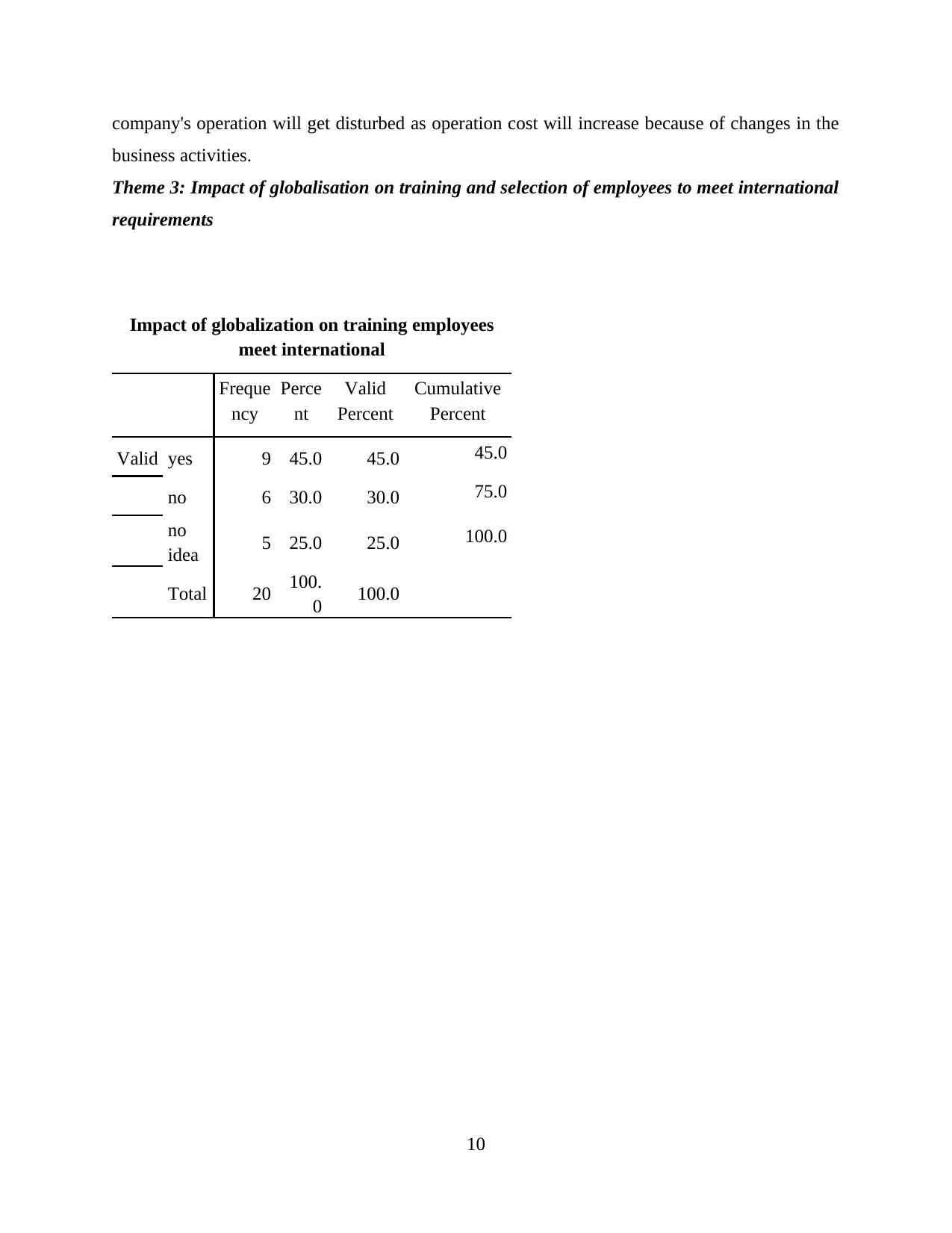
company's operation will get disturbed as operation cost will increase because of changes in the
business activities.
Theme 3: Impact of globalisation on training and selection of employees to meet international
requirements
Impact of globalization on training employees
meet international
Freque
ncy
Perce
nt
Valid
Percent
Cumulative
Percent
Valid yes 9 45.0 45.0 45.0
no 6 30.0 30.0 75.0
no
idea 5 25.0 25.0 100.0
Total 20 100.
0 100.0
10
business activities.
Theme 3: Impact of globalisation on training and selection of employees to meet international
requirements
Impact of globalization on training employees
meet international
Freque
ncy
Perce
nt
Valid
Percent
Cumulative
Percent
Valid yes 9 45.0 45.0 45.0
no 6 30.0 30.0 75.0
no
idea 5 25.0 25.0 100.0
Total 20 100.
0 100.0
10
⊘ This is a preview!⊘
Do you want full access?
Subscribe today to unlock all pages.

Trusted by 1+ million students worldwide
1 out of 27
Related Documents
Your All-in-One AI-Powered Toolkit for Academic Success.
+13062052269
info@desklib.com
Available 24*7 on WhatsApp / Email
![[object Object]](/_next/static/media/star-bottom.7253800d.svg)
Unlock your academic potential
Copyright © 2020–2025 A2Z Services. All Rights Reserved. Developed and managed by ZUCOL.





